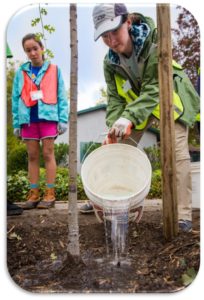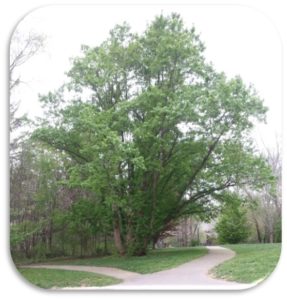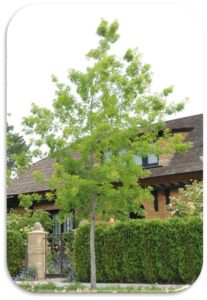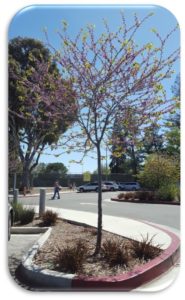- About Us
- Our Work
- Tree Info
- Get Involved
- Blog
- Volunteer
- Support Us
By Canopy Team on May 1, 2017

On April 6, 2017, Canopy staff members Michael Hawkins and Elise Willis presented at Gamble Garden about “Trees to Plant Now.” In this post, Part 2, we’ll cover the “who, where, and how” of tree planting, and offer a few more great trees to plant now.
Check out Part 1 for the “what, when, and why” of planting the right tree, plus five species recommendations.
As US Forest Service Researcher David Nowak said, “if you can only plant one tree, plant it in a city.” Planting trees in cities is essential to the livability of the urban environment, and by extension the health and well-being of all who make their home there. That is why Canopy is committed to growing the urban forest in the Mid-Peninsula and encouraging the community to take an active role in planting trees in their neighborhood.
When planting a tree at your home or in your neighborhood it is important to consider the following:
YOU! You can plant a tree to help grow the urban forest and make a direct impact to the health and beauty of your community. But rest assured, there are professionals who can help with your tree planting project:
Consulting arborists and tree care companies can assist you with the planting and maintenance of your current and future trees. Use Canopy’s Arborist List to find local practitioners.
Horticulturalists, gardeners, designers, and landscape architects are all great resources for planting trees. Many can help you select the right trees and plants for your needs, help with installation, and keep up the maintenance.
However, these professionals have varying levels of knowledge and experience with trees, and in many cases less “tree-specific” knowledge than needed! So be sure to find an expert in trees, and if you can, an expert in trees and landscaping—now that’s a keeper!
 How to Plant and Care for Your Tree
How to Plant and Care for Your TreeFind out how to plant a tree with Canopy’s step-by-step planting guide. Or come to a Canopy tree planting event and learn first-hand how to plant a tree! Check out our calendar for upcoming plantings.
Once the tree is planted, the next step is watering. Unfortunately, most people water too little too often, or not at all. To learn how to water your newly planted tree and keep it thriving as it grows, check out Canopy’s Tree Watering Guidelines.
After the tree is planted, use the Rule of 3’s to guide your watering:
After the initial three weeks, move towards watering every other week. The following year water deeply about once a month, and widen the watering basin.
 Along with watering, additional care is needed to help your young tree establish and grow strong:
Along with watering, additional care is needed to help your young tree establish and grow strong:
Learn more about watering and caring for your young tree here.

Category: Medium deciduous
#1 reason to plant: It’s so pretty
Interesting fact: There is a great fully mature example at the SF Arboretum
Pros: Excellent flowers and fall color; Drought tolerant
Cons: Not very well tested locally
Tips: Becoming more available at nurseries

Category: Medium Evergreen fruit tree
#1 reason to plant: Duel purpose
Pros: great investment
Cons: Frost sensitivity
Interesting fact: You can grow it here and not many other places
Tips: Fuerte, Bacon, Jim Bacon among the best; know if you’re getting A type and B type for pollination purposes

Engelmann Oak – Quercus engelmannii
Forest Green Oak – Quercus frainetto
Southern Live Oak – Quercus virginiana
Shumard Oak – Quercus shumardii
Cork Oak – Quercus suber
Category: Various oaks
#1 reason to plant: Many better suited to urban areas
Interesting fact: 600 separate species
Pros: Native mimicking trees and wildlife habitat
Cons: Unclear exactly how well they mimic our native oaks

Large Deciduous:
Silver Linden – Tilia tomentosa
Chinese Elm – Ulmus parvifolia
Large Evergreen:
Fern Pine – Afrocarpus gracilior
Deodar Cedar – Cedrus deodara
Willow-leaved Pepper – Eucalyptus nicholii
Silver-dollar Gum – Eucalyptus polyanthemos
Canary Island Pine – Pinus canariensis
Medium Deciduous:
Persimmon – Diospyros kaki ‘Fuyu’ & Diospyros kaki ‘Hachiya’
Chinese Pistache – Pistachia chinensis
Medium Evergreen:
Hollywood Juniper – Juniperus chinensis ‘Torulosa’
Bay Laurel – Laurus nobilis
Cajeput – Melaleuca quinquenervia
Yew Pine – Podocarpus macrophyllus
Olive – Olea europaea
Small Deciduous:
Trident Maple – Acer buergerianum
Eastern Redbud – Cercis canadensis
Western Redbud – Cercis occidentalis
Crape Myrtle – Lagerstroemia hybrids
Small Evergreen:
Loquat – Eriobotrya japonica & Eriobotrya deflexa
Water Gum – Tristaniopsis laurina